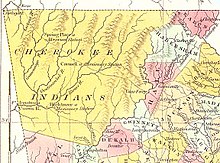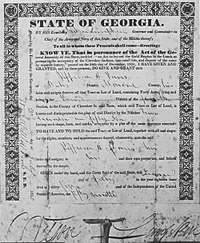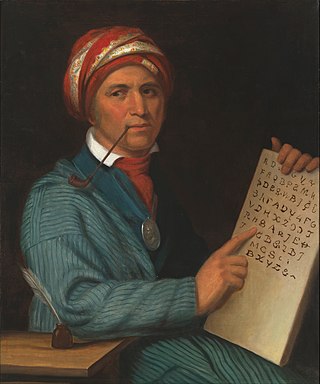
The Cherokee are one of the Indigenous peoples of the Southeastern Woodlands of the United States. Prior to the 18th century, they were concentrated in their homelands, in towns along river valleys of what is now southwestern North Carolina, southeastern Tennessee, southwestern Virginia, edges of western South Carolina, northern Georgia and northeastern Alabama consisting of around 40,000 square miles

The Muscogee, also known as the Mvskoke, Muscogee Creek or just Creek, and the Muscogee Creek Confederacy, are a group of related Indigenous peoples of the Southeastern Woodlands in the United States. Their historical homelands are in what now comprises southern Tennessee, much of Alabama, western Georgia and parts of northern Florida.
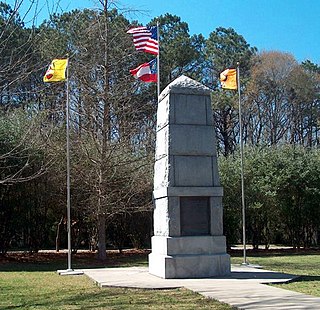
The Trail of Tears was an ethnic cleansing and forced displacement of approximately 60,000 people of the "Five Civilized Tribes" between 1830 and 1850 by the United States government. As part of the Indian removal, members of the Cherokee, Muscogee (Creek), Seminole, Chickasaw, and Choctaw nations were forcibly removed from their ancestral homelands in the Southeastern United States to newly designated Indian Territory west of the Mississippi River after the passage of the Indian Removal Act in 1830. The Cherokee removal in 1838 was brought on by the discovery of gold near Dahlonega, Georgia, in 1828, resulting in the Georgia Gold Rush.

Wayne County is a county located in the southeastern part of the U.S. state of Georgia. As of the 2020 census, the population was 30,144. The county seat is Jesup.

John Ross was the Principal Chief of the Cherokee Nation from 1828 to 1866; he served longer in that position than any other person. Described as the Moses of his people, Ross influenced the nation through such tumultuous events as the relocation to Indian Territory and the American Civil War.

The Treaty of New Echota was a treaty signed on December 29, 1835, in New Echota, Georgia, by officials of the United States government and representatives of a minority Cherokee political faction, the Treaty Party.

The Chief Vann House is the first brick residence in the Cherokee Nation, and has been called the "Showplace of the Cherokee Nation". Owned by the Cherokee Chief James Vann, the Vann House is a Georgia Historic Site on the National Register of Historic Places and one of the oldest remaining structures in the northern third of the state of Georgia. It is located in Murray County, on the outskirts of Chatsworth in northwest Georgia, which has a commanding view of the land around it and of the Cohutta Mountains, about 10 miles (16 km) to the east.

The Gold Lottery of 1832 was the seventh lottery of the Georgia Land Lotteries, a lottery system used by the State of Georgia between the years 1805 and 1833 to redistribute annexed Cherokee land. It was authorized by the Georgia General Assembly by an act of December 24, 1831 a few years after the start of the Georgia Gold Rush. The act specified that approximately one third of the 160-acre (0.65 km2) land districts to be distributed by lottery under the act of December 21, 1830, be designated as gold districts of 40 acres (160,000 m2) each and to be distributed in a separate lottery. The drawings for the Gold Lottery of 1832 occurred between October 22, 1832 and May 1, 1833 and applied to land that had been owned by the Cherokee Nation.
The Georgia Resolutions of 1827 were a response to the Cherokee's refusal to cede their territory within the U.S. state of Georgia. The resolutions declared the state's right to title, jurisdiction, and authority over all the land within its borders. They also stipulated that Indigenous people were tenants of Georgia at the state's will, and Georgia reserved the right to coerce obedience from all of its tenants, white, red or black. The resolutions were intended to pressure the federal government to prioritize its responsibility to Georgia over its responsibility to the Cherokee Nation, although it did not achieve its desired effect until the Jackson administration came into power.
The Cherokee have participated in over forty treaties in the past three hundred years.
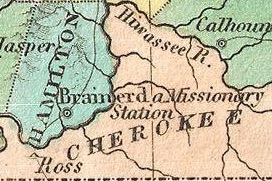
Cherokee removal, part of the Trail of Tears, refers to the forced relocation between 1836 and 1839 of an estimated 16,000 members of the Cherokee Nation and 1,000–2,000 of their slaves; from their lands in Georgia, South Carolina, North Carolina, Tennessee, and Alabama to the Indian Territory in the then Western United States, and the resultant deaths along the way and at the end of the movement of an estimated 4,000 Cherokee and unknown number of slaves.
John Martin was a notable judge of the Cherokee Tribal Court. He was a highly educated member of the tribe, although he was only one-eighth Cherokee. A biographer describes him as blond, blue-eyed and a person who could easily pass for white. He had no formal training in law, but he was one of the first men appointed to serve as a judge on the Cherokee Tribal Court, which was established in 1822. After his term as judge ended in 1828, he was addressed as Judge Martin for the rest of his life. He also served the Cherokee Nation as Treasurer, He was also a member of the Cherokee Constitutional Convention that led to the formation of a real national government. In 1837, he removed from Georgia to Indian Territory, where he was elected as the first Chief Justice of the newly created Cherokee Supreme Court in 1839. He served until his death the following year.
The Treaty of Indian Springs, also known as the First Treaty of Indian Springs and the Treaty with the Creeks, is a treaty concluded between the Muscogee and the United States on January 8, 1821 at what is now Indian Springs State Park.
The 1805 Land Lottery was the first lottery of the Georgia Land Lotteries, a lottery system used by the U.S. state of Georgia between the years 1805 and 1833 to appropriate the Cherokee and Muscogee land. The lottery was authorized by the Georgia General Assembly by an act of May 11, 1803, with drawings occurring in 1805. The lottery redistributed land in Baldwin, Wayne, and Wilkinson counties. 490-acre plots were redistributed in Wayne County and 202.5-acre plots were redistributed in Baldwin and Wilkinson counties.
The 1807 Land Lottery was the second lottery of the Georgia Land Lotteries, a lottery system used by the U.S. state of Georgia between the years 1805 and 1833 to appropriate and redistribute Cherokee and Muscogee land. The 1807 lottery was authorized by the Georgia General Assembly by an act of June 26, 1806. The lottery redistributed land in Baldwin and Wilkinson counties. 202.5 acre lots were redistributed in both counties. Registrations for the lottery took place between June 26 and September 26, 1806, with drawings occurring between August 10 and September 23, 1807. Fortunate drawers from the previous 1805 lottery were excluded.
The 1820 Land Lottery was the third lottery of the Georgia Land Lotteries, a lottery system used by the U.S. state of Georgia between the years 1805 and 1833 to appropriate and redistribute Cherokee and Muscogee land. The 1820 lottery was authorized by the Georgia General Assembly by acts of December 15, 1818, and December 16, 1819. The lottery redistributed land in Baldwin and Wilkinson counties. The 1820 lottery were used to steal Muscogee land and redistribute it to settler of various qualifications. Following the Creek War (1813–1814), President Andrew Jackson demanded from the Muscogee an immense area of land which would become the southern third of the entire state of Georgia. A second section of land in northeast Georgia was included. This other, smaller section defined the eastern end of the Cherokee Nation for 12 years. Muscogee land was appropriated and redistributed in Appling, Early, Gwinnett, Habersham, Hall, Irwin, Rabun, and Walton counties.
The 1821 Land Lottery was the fourth lottery of the Georgia Land Lotteries, a lottery system used by the U.S. state of Georgia between the years 1805 and 1833 to appropriate Cherokee and Muscogee land and redistribute it to settlers. The 1821 lottery was authorized by the Georgia General Assembly by an act of May 16, 1821. The lottery redistributed land in Dooly, Fayette, Henry, Houston, and Monroe counties.
The 1827 Land Lottery was the fifth lottery of the Georgia Land Lotteries, a lottery system used by the U.S. state of Georgia between the years 1805 and 1833 to appropriate and redistribute Cherokee and Muscogee land to settlers. The 1827 lottery was authorized by the Georgia General Assembly by an act of June 9, 1825. The lottery redistributed Muscogee land in Carroll, Coweta, Lee, Muscogeee, and Troup counties.
The 1832 Land Lottery was the sixth lottery of the Georgia Land Lotteries, a lottery system used by the U.S. state of Georgia between the years 1805 and 1833 to appropriate Cherokee and Muscogee land to settlers. The 1832 lottery was authorized by the Georgia General Assembly by acts of December 21, 1830 and December 24, 1831. The lottery redistributed Cherokee land in Cass, Cherokee, Cobb, Floyd, Forsyth, Gilmer, Lumpkin, Murray, Paulding, and Union counties.
The 1833 Fractions Lottery was the eight and final lottery of the Georgia Land Lotteries, a lottery system used by the U.S. state of Georgia between the years 1805 and 1833 to appropriate and redistribute previous Cherokee and Muscogee land to settlers. The 1833 fractions lottery was authorized by the Georgia General Assembly by an act of December 24, 1832. The lottery redistributed land from the original Cherokee territory and twenty-two lots that were not placed into prize wheels during previous lotteries.

